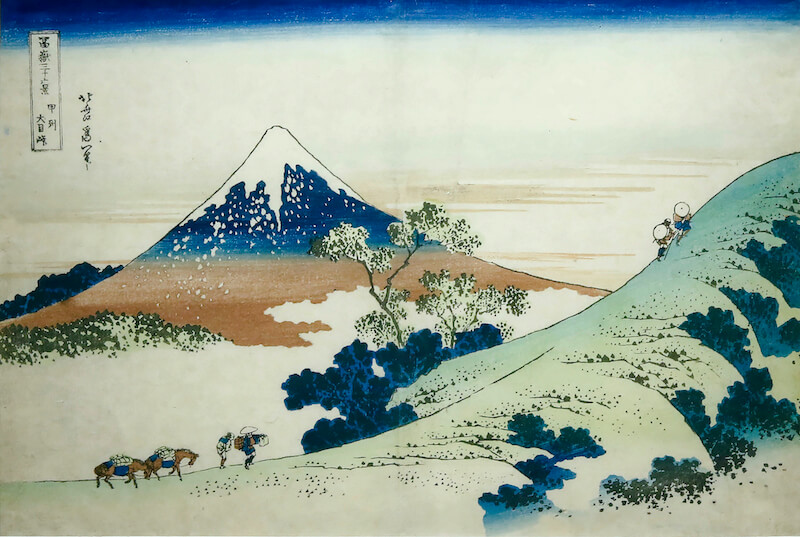Explore Mount Fuji
Mount Fuji is Japan’s highest mountain, standing at 12,389.2 feet, or 3,776.24 meters, and is located about 60 miles southwest of Tokyo. An active volcano that last erupted between 1707 and 1708, the peak is famous for its perfectly symmetrical conical form, which has been the subject of many paintings and prints and also of reverence as a powerful sacred site. For centuries, the mountain has been visited by pilgrims, climbers and sightseers, and many of the surrounding towns have hosted these travelers, offering food, lodgings and a chance to dip in the local hot springs (onsen) that abound in this volcanic landscape. It was added to UNESCO’s World Heritage List as a Cultural Site in 2013.

Inume Pass, Kōshū from the series Thirty-Six Views of Mt. Fuji series by Katsushika Hokusai, c. 1829
In this image, a group of travelers make their way slowly up the slope of Inume Pass in the foreground and in the distance a snow-topped Mount Fuji reigns majestically over the scene. Though Hokusai shows the beauty of the landscape in these works, he also sympathizes with the people and animals who had to navigate it, often journeying hundreds of miles to reach their destination. Here, the bowed heads of the horses at the left suggest the hardships of such travel. The two figures in the upper right who seem close to the peak of the pass look over at Mount Fuji in the distance, perhaps for encouragement. Seeing its perfect form reassures them they will soon summit and start making their gentle descent down the other side.

Hodogaya on the Tōkaidō Road from the series Thirty-Six Views of Mt. Fuji by Katsushika Hokusai, c. 1829
Around 1830, Katsushika Hokusai (1760-1849) designed The Thirty-Six Views of Mt. Fuji (Fugaku Sanjūrokkei), a print series celebrating Japan’s tallest and most sacred mountain. Most of the views spotlight the interaction between people and the natural landscape, such as the powerful sea in The Great Wave. Here, a group of travelers journey west from Edo (modern Tokyo) towards Kyoto along the Tōkaidō, the route connecting the two cities. They appear weary after descending the hill on the right; the front palanquin bearer wipes his brow while his partner kneels down to tie his sandal, and the rider on the horse bows forward as if falling asleep. The pine trees lining the road seem to open up on either side of the great mountain like stage curtains revealing the drama beyond — a scene that only the man in the center leading the horse appears to appreciate.

The Exposed Buddha at Jōsen Temple by Utagawa Hiroshige, c. 1835
Utagawa Hiroshige's (1797-1858) most famous landscape prints featured views beyond the capital. In this print, he depicts the Great Buddha at Kamakura, a huge bronze statue that was originally built in the 13th century at the Kōtoku Temple. The bronze Buddha was originally housed in the Great Buddha Hall, but the structure was damaged by typhoons in 1334 and 1369 and then completely washed away in 1498 by a tsunami caused by the Nankai Earthquake. The statue itself has also been damaged and repaired several times but it has sat exposed for over 500 years. As if to highlight the power and might of the natural elements, Hiroshige exercises artistic license by showing the iconic statue with the even more iconic and volcanic Mount Fuji in the distance.
The View of Mt. Fuji Today
#ASMR Japan | Traveling through Shizuoka

Explore Each Region
Return to Part 2
Nature: The Beauty of the Japanese Landscape

Main Exhibition & Virtual Tour

*Note: Japanese names in this exhibition are written in the traditional Japanese order, with the family name first and personal name last. However, if an artist has come to be known by a single name, (e.g., Hokusai and Kunisada) that name will be used for subsequent mentions.

